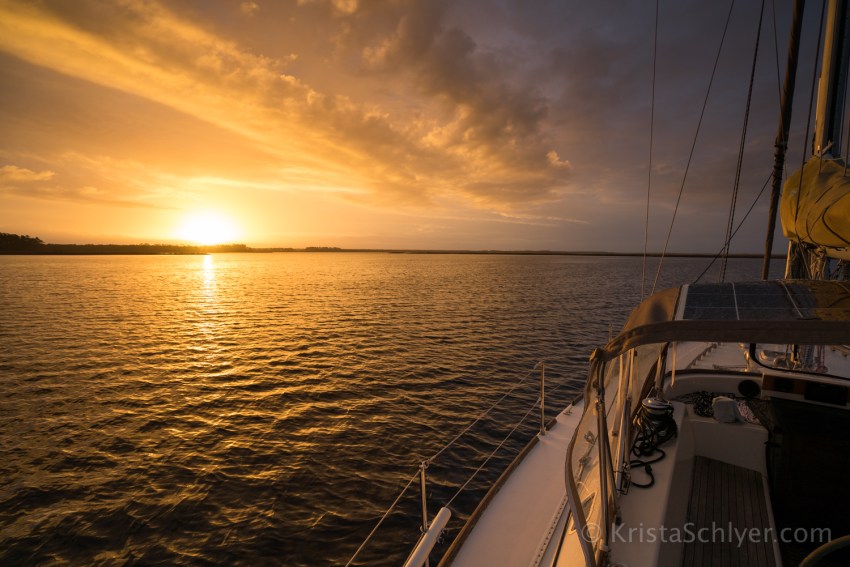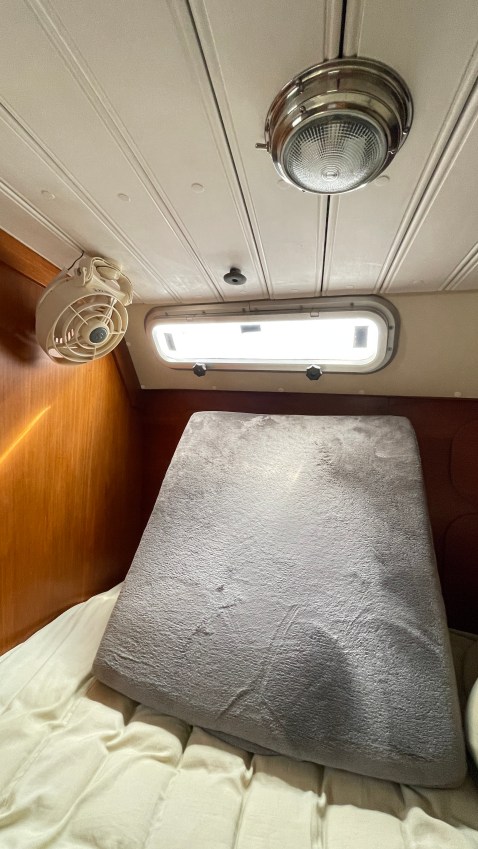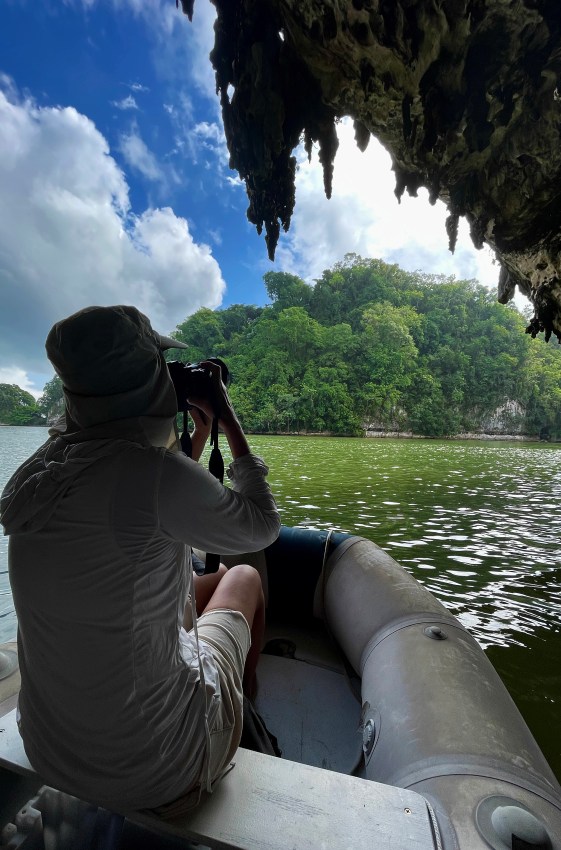Many early religions had the sun at the pinnacle of their pantheons. The reason for this becomes more apparent with every minute passed under the direct stare of the tropical sun.
This thought comes to me as we are cleaning Maggie May’s decks in the Dominican Republic. The yellow face is pressing down upon my cranium with its orange-hot thumb, causing my knees to buckle in supplication. After a mere 20 minutes my thoughts grow hazy and my skin begins to sting, I scramble for shade and crouch low, shaking my feeble fist at the yellow face. Just leave me be! Por favor.
It’s not just me. The most important person on earth, the most powerful, the most beautiful, graceful, the strongest will bend and weep in the face of the unrelenting sun, this central cog in the nature machine, which gives and takes everything we have, right down to our very own bodies. You would think we humans would have more humility in the face of this blinding force, but that is not our way.

I myself never gave much thought to the sun before this voyage. Sure, I luxuriated in the warmth of a sunny spring day after the enduring chill of a frigid winter. I strategized about where to plant my tomatoes so they would have the most sunlight. I schmeared on sunscreen for protection. But I didn’t really think much about the sun as a power responsible for, well, my whole world. I now think on it every day as my life has become much more obviously wound up in the cycles of the sun.
From the sun comes everything. The golden fruit of a mango, the wind in our sails, sunburn and heat exhaustion, the tides to some extent, hurricanes, cabbage, the shifting patterns of rain, drought, dehydration, warmth. Coffee.
I am pouring myself some just now. I heated the water for it by plugging into our boat electrical system, a bank of Firefly batteries connected by wires to 5 solar panels which are at this very moment collecting solar energy like leaves on a tree from the Sun Almighty.
These leaves power the fan that is blowing on me, the rice I’ll have for lunch, the batteries in my camera, the blender for making Bill’s signature banana coladas, the lights, the automatic pilot, the VHF, the freshwater pump, the emergency bilge pump, the electronic charts, all of it, everything electrical that we have used for a year and a half has been powered almost entirely by solar energy, with some assist from the wind— though in reality that is also solar power since the sun makes the wind.
THE ENERGY PLAN

Several years before we moved onto the boat, Bill began devising an energy strategy that would allow us to be as free from fossil fuel use as we possibly could be. We’ve had some challenges over the course of this sailing dream, things that in our lowest moments we have grieved as personal failures (or at times a cruel joke of Poseidon), but we’ve also had successes beyond expectation. In the arena of energy independence, I don’t think even Bill anticipated how successful we would be.
The first step of the strategy was to build in efficiency and conservation everywhere, to minimize energy needs before even thinking about how to meet that need. Often in energy policy this comes as an afterthought, we think first of securing enough energy for the current need, rather than reducing energy demand through efficiency and conservation so we don’t need to supply so much. (If you’ve already secured the energy for current need, why conserve? Aside from some pesky distant future worry like climate change, which Homo sapiens can’t get their heads around enough to afford it the deadly seriousness it deserves.)
On the Maggie May the first practical step we took was to get rid of the air conditioning and the generator that came on the boat. This wasn’t too hard a decision as neither of them worked properly, but we could have chosen to repair them or replace them. This would have meant carrying more fuel on board and using fossil fuels to keep ourselves cool in a world that is warming due to excessive use of fossil fuels. We decided we could do without it and simplify the boat and our lives, while learning to live the way most of the world’s humans, and all of its non-human animals, live.
Bill also took the important step of changing out every light bulb on the boat, most of which were either incandescent or halogen, and replacing them with more energy efficient LED lights. There are a lot of lights on a boat, even small boats like ours with only a few hundred square feet of living space. We needed about 35 new light bulbs. Some of these lights are linked to safety and survival, and they run from bow to stern and up to the top of our 50-foot mast. Having long-lasting, low energy lights not only significantly cut our electrical demand (the demand from lighting is now about a fifth of what it was), it increased safety by increasing brightness of navigation lights and decreasing the number of times we’d need to climb the mast to replace bulbs.

The lack of air conditioning would obviously mean much warmer temperatures on the boat. Bill bought foil-faced recycled denim insulation to insulate every nook and cranny he could find on the SV Maggie May. The insulation reflects radiant heat and cools the boat, so we are slightly more comfortable on the hottest days (currently that is every day) but more importantly we require less energy to run our fridge—the biggest energy hog on the boat—and have less need for fans to keep ourselves coolish. I also made some raggedy white shades for our boat hatches and ports which helps keep the temperature inside the boat down and wards off pirates who think our boat looks too trashy to be worth their time.
We minimized electronics as much as possible. We’ve seen boats out here with washers and dryers, big screen TVs, huge freezers and everything else you can imagine to make life on the water exactly like a life of comfort on land. But it all requires energy and there is only so much space on a boat for solar and wind. So many people have generators or use their diesel engines frequently to charge their batteries.
When we had tightened our energy consumption belts as much as possible, we bought five solar panels and a Rutland wind generator. Bill had calculated that the solar panels, with a 428 watt total output, would meet most of our needs and that the wind generator — capable of 500 watts —would serve as a backup on cloudy, windy days.
At the same time Bill upgraded the electrical system and, as a back-up for the back-up of the wind generator, added a new more powerful alternator on our Yanmar diesel inboard (more on this diesel engine in a bit). The alternator can be used to charge the battery bank when the diesel engine is running. The new alternator would have the ability to charge the batteries faster, thus requiring less diesel fuel.
But everything depended on the battery bank. Our lead acid batteries that came on the boat when we bought her were struggling to hold a charge. They were essentially old-school car batteries. If we were going to gain some distance from fossil fuels, we needed better batteries. Bill researched our options and we considered whether to replace the batteries with the same kind of cheap battery, to buy new expensive lithium ion batteries, or go the middle ground with some type of absorbed glass mat (AGM) battery. Bill found a relatively new kind of AGM battery called Firefly that uses carbon foam in its internal structure. They function somewhat like a lithium ion battery in terms of capacity, but the price is closer to the standard AGM. Being a new and somewhat untested technology, the choice of Firefly batteries was a bit of a risk, but they have performed very well for us over the past year and a half.
When we bought our 30-year-old boat 8 years ago, she came with a gasoline outboard for her dinghy, which of course died shortly before we were about to leave on this voyage. We decided to replace it with an Electric Paddle, a light electric engine I can carry in one hand. This has its downsides (see below) but the greatest upside was that we would not need to bring any gasoline on board the boat.

ENERGY STRATEGY RESULTS
For 18 months we have lived on sun power. Once or twice we have been under extended cloudy skies and the wind generator has stepped in to save the the day. But we have never once needed to start the diesel engine to charge the batteries. The solar panels have kept up with our needs even on partly cloudy days. The feeling this engenders for me is a sort of weightlessness, I am unburdened of the undercurrent of guilt I feel on a daily basis at home, where most of our energy comes from the dirty electric grid. We purchase through a wind power supplier, but it is industrial wind. (I feel better about wind than coal, but it is still infrastructure and it disrupts and degrades the land and poses dangers for wildlife.) We could put solar panels on our house, but it would require cutting down a large walnut tree that provides shade for the house and almost everything for a suite of animals who live in it.
On the boat it’s simple: we collect sun energy as though foraging for mushrooms or collecting rainwater.
There are two caveats. The Yanmar diesel inboard engine on Maggie May, and the propane stove.
Budget is always a factor. Had we unlimited resources we could have transitioned to an electric engine. But that was not a viable option. The cost of replacement would have been at least $20,000. We didn’t have it. But we are primarily a wind and sail driven vessel. And we use our engine as little as possible, to get in and out of marinas and tight anchorages, and to get to our destinations safely when the wind shifts or dies. It is primarily a safety device rather than a means of propulsion. We buy on average about 40 gallons of fuel every 4 months and that may decrease once we start heading a better angle on the trade winds (ie, south or west; going east can require some motor sailing because the angle on the wind is at times not conducive to safely making our destination).
To minimize our use of propane we bought small electric appliances that could run off of our battery bank, including a cute two-cup rice cooker and a small super-efficient hot water pot. Many days we get by with just these appliances which keeps our fossil fuel use down and keeps the heat from cooking at a minimum. We refill a small propane tank about once every six months.
Lessons and Challenges
Choosing not to have air conditioning was no great loss. But one thing has made it much harder, the fact that humans have polluted most of our waters. Cooling off would be as simple and enjoyable as jumping in the water. But the majority of the past year and a half we have been traveling through unhealthy waters–along much of the United States East Coast and most of the Dominican Republic—essentially everywhere except the Bahamas. The fact of this state of affairs is nothing short of tragic. But we stay cool by finding trees to sit under during the hottest part of the day, pouring cups of drinking water on our heads, creating boat shade however we can, keeping our daytime activity levels low and cooking only at night. Not having AC also means we have to be more vigilant about mold growth without the dehumidifying effect of climate control. We spray down the boat often with vinegar+water+tea tree oil.
We are both very glad we opted not to have a generator. The comforts and luxuries afforded by these machines are those we can do without, along with the noise, smell and carbon footprint of a generator. The one thing we miss is the ability to fill scuba tanks, and we may want to remedy this at some point.

Our electric dinghy engine is quiet, doesn’t smell of fuel or pollute the water, requires no maintenance and is super light and easy to get on and off the boat. It is slow, but this to me is a benefit as we are more likely to see wildlife and notice cool things that are happening around us. There are situations where speed can be helpful, say when you are chased by a thunderstorm. But this happens rarely if we are being careful. The other drawback for us is the distance our motor can go, only about 5 miles and that is only at half speed. Other electric motors have a bigger battery capacity, but they also are heavier and bulkier. Trade offs.
The solar has performed so well, and we minimized our energy needs so well, that Bill is often heard mourning the purchase of the wind generator and the new alternator. To which I say, “You never know, they may save our lives one day.” But it may also turn out that they were a huge waste of embodied carbon and money.
Which brings me to embodied carbon.
I was not going to put this blog out there without some discussion of embodied energy consumption. My partner is Bill Updike after all. This is a phrase I would not be aware of if not for him. Every single thing we buy new or construct has a cost in embodied energy and carbon. The energy required to mine the raw materials, the energy required to fabricate and transport the materials to be sold. Every item of clothing, bite of food, tool, pillow, cup of coffee, battery, engine, road, wall, bridge. We rarely count these costs when making policy decisions or governing our own lives. But choosing not to buy or construct is the greatest rebellion against our dark role in the breakdown of global biodiversity and our climate system.

In our lives and on the boat we try not to buy, or we buy local or used as much as possible. We didn’t buy a new dinghy, even though ours is 20+ years old and falling apart (and we have named it Dingy), because if we can make it through the trip without buying one, Dingy will have a longer, more fulfilled life and the world will have a little bit less toxic vinyl to have to contend with. But we did buy an inflatable kayak so we could have some independence of each other (this is a serious safety factor) and a backup for Dingy. It may turn out we didn’t need the wind generator and the new alternator. There is embodied carbon in our emergency life raft and we may, (hopefully), never need it. But we may. There are always these choices and while we have tried to make the best choices we could by conserving and building in efficiencies, and installing solar and wind power, I know we will find places where we have not made the best decisions.
But the best decision can at times be unclear or just out of reach. So at best we reach for the decision that is informed by facts and leans toward a healthier world for everything under the Sun Almighty.



As always, a thoughtful and thoroughly enjoyable read, Krista. It’s like a favorite meal or the best cup of coffee. I’m always sad when I finish! Sending love to you both.
Thank you Sandy! Love hearing this!
I love you both more and more with each published blog post!
🙂 love you back
I love how thoughtfully and intentionally you approach each decision – all those that went into preparing for this trip, and those along the trip as well. I’m inspired! Thank you!
Thanks Cat!
I’m in awe of your journey and super glad you are able to ward off the pirates with the raggedy curtains!
Thank you! Hopefully we never end up field testing that strategy.
This is great info as I move into converting the new house to a more sustainable interface and, a little further down the road, when I build the off-grid structure on the land in Belen. Love you guys!
Looking forward to helping someday Nick. Love you brother!